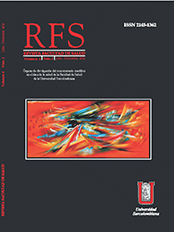Hematologic toxicity associated with sulfonamides and pyrimethamine treatment in HIV positive patients with cerebral toxoplasmosis at tertiary-slevel hospital in Colombia
##plugins.themes.bootstrap3.article.main##
Objective. To determine the frequency of hematologic adverse effects associated with treatment for cerebral toxoplasmosis in HIV / AIDS patients. Design: Retrospective case series. Location: University Hospital Hernando Moncaleano Perdomo (HMP), Neiva, Colombia. Population. Patients with cerebral toxoplasmosis and HIV / AIDS treated at the infection service unit between 2006 and 2009. Población. Pacientes con toxoplasmosis cerebral y VIH/SIDA atendidos en el servicio de infectología entre 2006-2009. Results. 51 patients were evaluated during the study period. 40 (78%) were men. The average age was 33 years. 25 patients had cerebral toxoplasmosis as the first marker of HIV infection. 60.7% of cases had hematologic toxicity. 42% of patients had anemia before treatment. The peak onset of bone marrow toxicity was the sixth day of the start of treatment schedule. The anti-toxoplasma scheme that was most commonly associated with myelotoxicity was the combination of pyrimethamine/sulfadoxine, trimethoprim-sulfamethoxazole and clindamycin in 48% of cases.
Downloads
##plugins.themes.bootstrap3.article.details##
Fauci B, Hauser L, Loscalzo J. Harrison. Principios de medicina interna. XVII edición; Mc Graw Hill 2009;7(282):1181-1184.
Silva F, Torres A, Prada G. Encefalitis por toxoplasma y SIDA: Análisis de 27 episodios. Revista Panamericana de Infectología 1997;1:4-9.
Lizarazo J, Castro F, M. de Arco. Infecciones oportunistas del sistema nervioso central en pacientes con VIH atendidos en el Hospital Universitario Erasmo Meoz, Cúcuta, 1995 2005, Infectio, 10 2006;226-231.
Osorio JC, Vallejo GS, Franco D. Determinación de las características clínico-epidemiológicas de la neuroinfección en pacientes con diagnóstico de VIH/sida en el departamento del Quindío. Infectio 2007;173-182.
Cardona N, Basto N, Gomez JE. Detection of Toxoplasma DNA in the Peripheral Blood of HIVPositive Patients with Neuro-opportunistic Infections by a Real-Time PCR Assay. Journal of Neuroparasitology 2011.
Secretaría de salud departamental, Sistema de Vigilancia epidemiológica (SIVIGILA), Boletín epidemiológico del Huila, 2008.
Centers for Disease Control and Prevention. Guidelines for Prevention and Treatment of Opportunistic Infections in HIV-Infected Adults and Adolescents Recommendations from CDC, the National Institutes of Health, and the HIV Medicine Association of the Infectious Diseases Society of America 2009;58:12-13.
Corral RH, Varela A, González I, Gutiérrez MI, et al. Toxoplasmosis en pacientes con infección por VIH. Boletín SIEI (ISS Cali) 1996;2:11-16.
Gómez JE, Alvarado F, Hernández C, et al. Tratamiento de la fase aguda de la toxoplasmosis cerebral con Clindamicina - Falcidar (pirimetamina - sulfadoxina) en pacientes infectados por VIH. Infectio 2001;5(3):162-168.
Fauci B, Hauser L, Loscalzo J. Harrison principios de medicina interna. XVII edición; Mc Graw Hill 2009;1199.
Gómez JE, Alvarado F, Hernández C, et al. Tratamiento de la fase aguda de la toxoplasmosis cerebral con Clindamicina - Falcidar (pirimetamina - sulfadoxina) en pacientes infectados por VIH. Infectio 2001;5(3):162-168.
Erik R, Vandendries, Reed E. Drews. Drug-Associated Disease: Hematologic Dysfunction. Crit Care Clin 2006;22:347-355.
Van der Ven AJ, Koopmans PP, van der Meer JW. Adverse reactions to co-trimoxazole in HIV infection. Lancet 1991;338(8764):431-433.
Richard H. Aster, and Daniel W. Bougie. Drug- Induced Immune Thrombocytopenia. N Engl J Med 2007;357:580-587.
Ray JB, Brereton WF, Nullet FR. Intravenous immune globulin for the treatment of presumed quinidine-induced thrombocytopenia. DICP 1990;24:693-695.
Pourrat O. Treatment of drug-related diseases by plasma exchanges. Ann Med Interne (París) 1994;145:357-360.
Christie DJ, Weber RW, Mullen PC, Cook JM, Aster RH. Structural features of the quinidine and quinine molecules necessary for binding of drug-induced antibodies to human platelets. J Lab Clin Med 1984;104:730-740.










